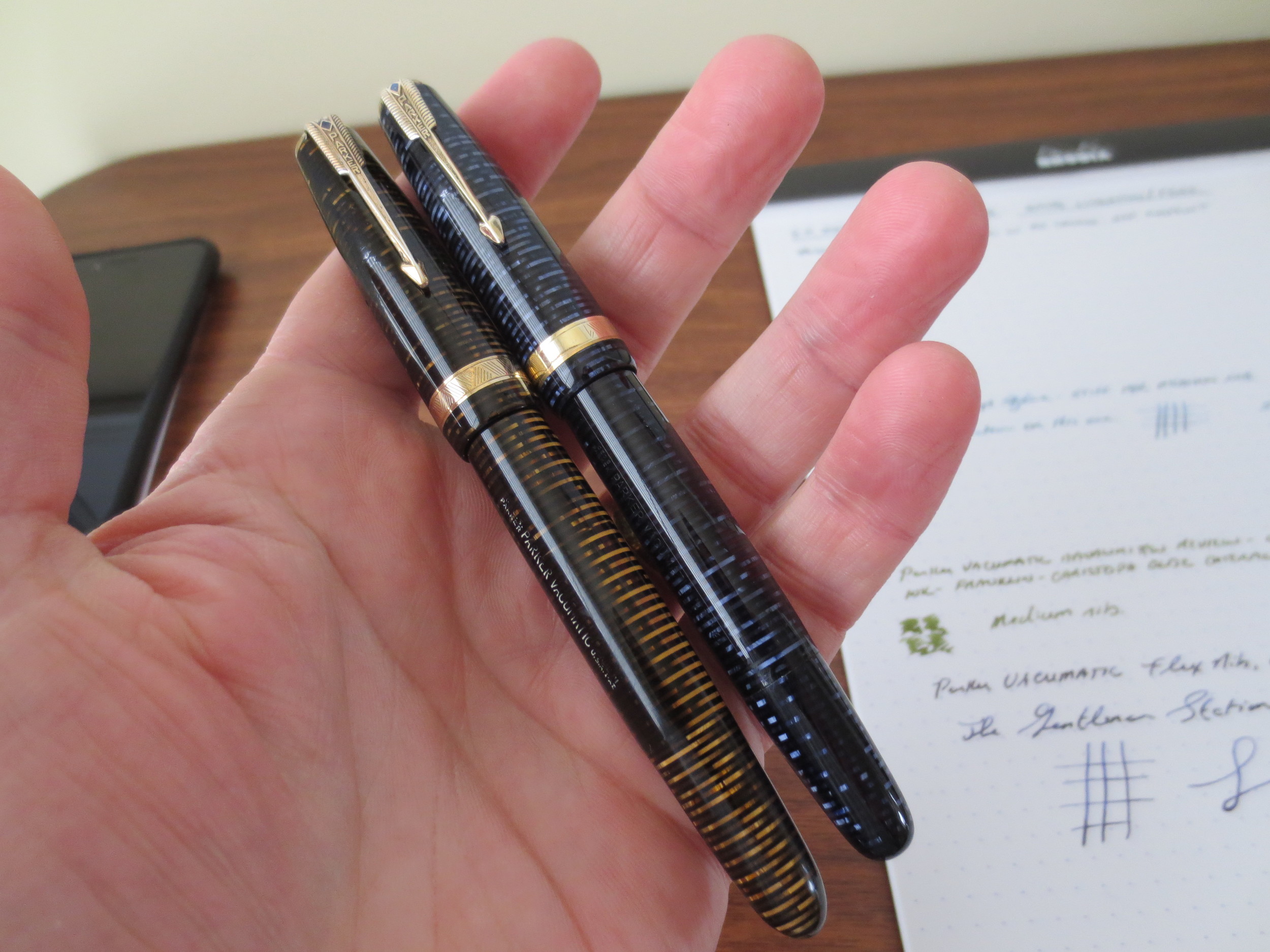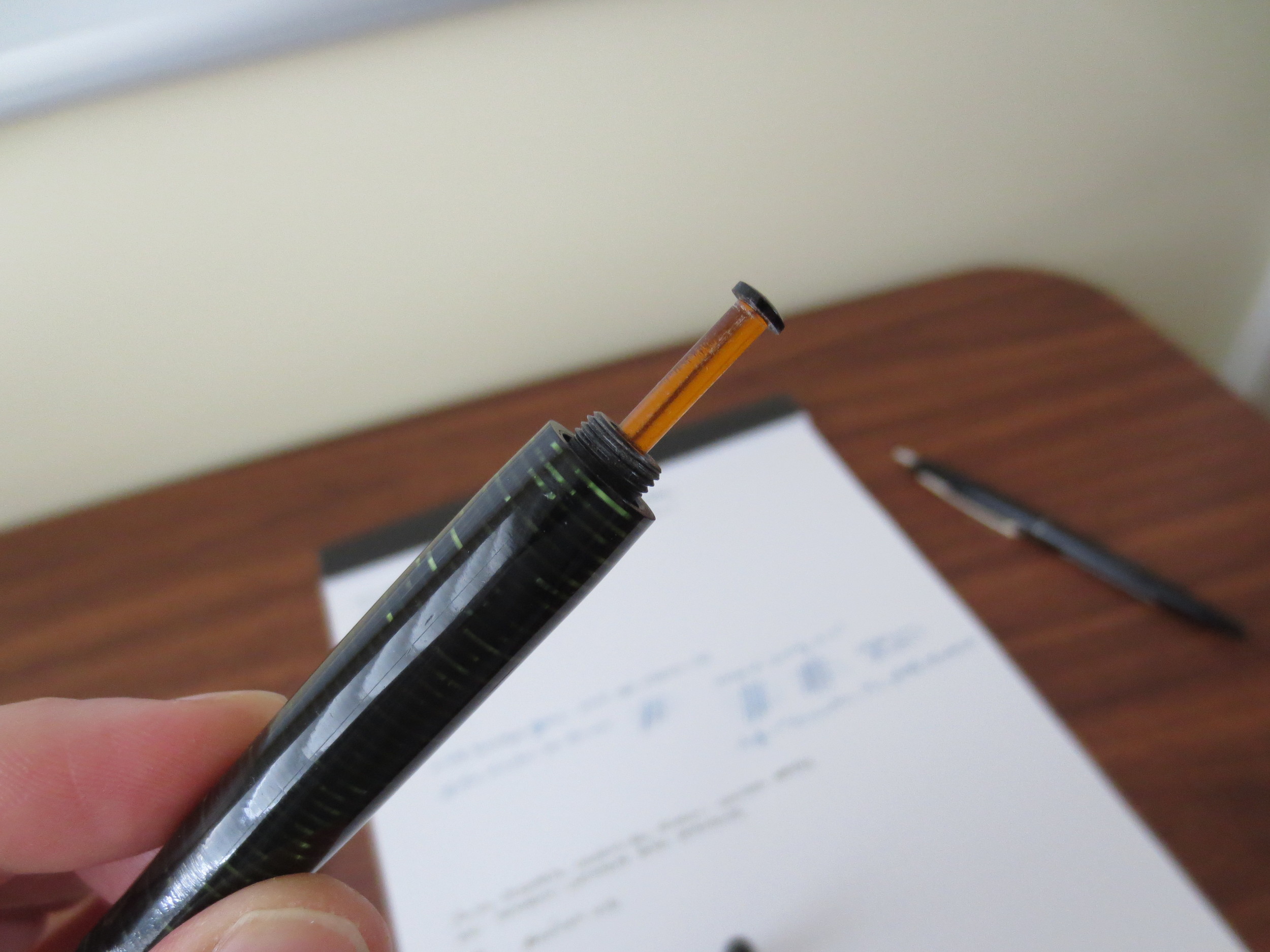And we come to the reason that I got into vintage pens to begin with: the Parker Vacumatic. I had no interest in vintage whatsoever until I came across these pens. For some reason, the “Vac” mesmerized me, and before I knew it I ended up with four of them.
My four vacumatics: Amber, Green, Blue, and Silver/Platinum. All are in respectable condition and see regular use.
The Vacumatic is a very popular vintage pen, and a favorite among collectors. These pens were manufactured by Parker throughout the 1930s and into the mid-1940s, with limited production continuing into the 1950s outside the United States. The most widely recognized Vacumatics are the pens with the Art Deco, striped celluloid pattern that resemble skyscrapers from the 1930s. These are the pens that I fell in love with, and I eventually acquired one of each color, with the exception of the more difficult to find Burgundy version. (Next pen show purchase, for sure.)
Many vintage pen collectors devote their entire hobby to collecting Vacumatics. One of the best known Vacumatic collectors and dealers is Dr. David Isaacson who runs the site Vacumania.com, which is a great place to purchase a quality Vacumatic that you know has been restored properly. (Be advised that you will likely pay a premium price, though perhaps not as much as you might fear.) My personal vintage pen collection isn’t that large, but a sizable portion of it is devoted to Vacumatics, and I plan to give Vacs some more attention in the future.
But where does the Vacumatic fall as a “user pen”? I didn’t get into fountain pens, vintage or otherwise, to simply purchase them, place them in a case, and look at them. (There’s nothing wrong with this approach—many people take much joy in collecting for the sake of collecting, though I’m not one of them.)
My emerald green Vac came with a very smooth medium nib. This is one of my favorite pens in my collection.
Here’s why I collect Vacs: They are excellent user pens, among the best vintage pens I have used on a day-to-day basis. They are the perfect size for me, hold a ton of ink via an interesting filling system, and the nibs typically work well for my style of writing, which is a hybrid of large/small caps printing and cursive, depending on how rushed I am.
I think some people avoid the Vacumatic because it can look fragile. The pens are made of celluloid, and the ones in good condition are still translucent, allowing the writer to view the ink level of the pen in the barrel. I for one assumed that this meant the celluloid was brittle, and was terrified that I would drop or crack the pen if I carried it around. I’ve never had this problem, and honestly, while I’m sure Vacs have broken, they’ve earned a reputation as a fairly durable writing instrument. Some of these pens are nearly 80 years old, and still going strong on a daily basis!
Before you dive into the world of Vacs (which can suck you in and drain your bank account very quickly), here are some points to keep in mind:
- As with any vintage pen, know what you are buying. The Parker Vacumatic was on the market for a very long time. The pen evolved over the years, so there are various models out there which all look different (some slightly different, others significantly so). A thorough discussion of the different Vacumatic models is beyond the scope of this short article—entire books have been written on the subject—but a good place to start for a first purchase is with the third generation Vacumatic Major (early-to-mid 1940s). My pens, shown in the pictures here, are third gen Vacs. They are generally regarded as quite sturdy, and the prices are fairly reasonable, anywhere from $100-200 restored, depending on factors such as the condition of the nib, barrel clarity, etc.
- Pay attention to restoration. It's worth paying more for a well-restored Vac. The filling systems aren't fragile, per se, but they have a lot of moving parts. I've had Vacumatics leak (and even once had the "pump" filler snap off) due to improper restoration jobs. I've done one or two Vac restorations myself, and while not difficult, they require more skill than simply re-sacking a pen.
- A Vac is the one pen that I would recommend purchasing at a pen show, so that you can have the opportunity to see the pen in person and try out the nib. And the nibs can be amazing! My silver pen turned out to have a bit of flex to it. (Pictures below) Medium and broad nibs are not as uncommon as they are on Parker 51s and other vintage pens.
- One final tip on filling and cleaning Vacumatics: when filling, remember that you will need to place the nib and section in the ink bottle and depress the plunger several times in order for the pen to fill completely. It works like a pump: keep pressing until bubbles stop coming out of the nib. Many people think there is something wrong with the pen when in reality they have only pressed once or twice. Cleaning/flushing the pen can be a bear. The easiest way to do so, in my opinion, is to depress the plunger multiple times very slowly, and allow the ink to drop out of the pen. While Vacs are great pens, they were not intended to swap inks frequently!






